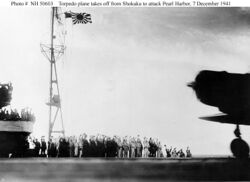Pearl Harbor (World War II): Difference between revisions
imported>Howard C. Berkowitz |
imported>Howard C. Berkowitz No edit summary |
||
| Line 20: | Line 20: | ||
===United States=== | ===United States=== | ||
==The attack== | ==The attack== | ||
===Preliminaries=== | ===Preliminaries=== | ||
[[Image:Japanese Kate in Pearl Harbor attack.jpg|thumb|250px|Japanese torpedo bomber taking off to attack Pearl Harbor]] | [[Image:Japanese Kate in Pearl Harbor attack.jpg|thumb|250px|Japanese torpedo bomber taking off to attack Pearl Harbor]] | ||
===First wave air attack=== | ===First wave air attack=== | ||
[[Image:Japanese view of Pearl Harbor attack.jpg|thumb|left|300px|Japanese perspective approaching Battleship Row]] | |||
The picture, taken fro [[USS Nevada (BB-36)]] with flag raised at stern; [[USS Arizona (BB-39)]] with repair ship [[USS Vestal (AR-4)]] outboard; Tennessee (BB-43) with West Virginia (BB-48) outboard; [[USS Maryland (BB-46)]] with [[USS Oklahoma (BB-37)]] outboard; [[USS Neosho (AO-23)]] and [[USS California (BB-44)]]. | |||
West Virginia, Oklahoma and California have been torpedoed, as marked by ripples and spreading oil, and the first two are listing to port. Torpedo drop splashes and running tracks are visible at left and center. White smoke in the distance is from Hickam Field. Grey smoke in the center middle distance is from the torpedoed USS Helena (CL-50), | |||
===Second wave air attack=== | ===Second wave air attack=== | ||
===Arguments for and against a possible third strike=== | ===Arguments for and against a possible third strike=== | ||
Revision as of 21:56, 25 August 2010
For the geographic area, see Pearl Harbor
On December 7, 1941, units of the Imperial Japanese Navy conducted air and submarine operations against American forces in the Battle of Pearl Harbor. This battle was a key element in the major Japanese escalation of what they call the Pacific War.
While the United States had intelligence suggesting a high probability of Japanese attacks in December 1941, and some specific information that either did not reach the Pearl Harbor commanders, Admiral Husband Kimmel (Navy) or Lieutenant General Walter Short (Army), the attack was a tactical surprise.
Few battles, and the circumstances leading to them, have been studied as extensively as this one. Many concepts of the discipline of intelligence and warning resulted from this action.
Japanese operational concept
U.S. intelligence and planning
Communications intelligence
Threat assessment
Sabotage vs. air attack
Short was convinced that the major threat to his aircraft was sabotage by residents of Japanese ancestry, so he had them parked in close formation for ease in guarding them against ground attack. This made them dense targets for strafing and bombing.
Implications of the Battle of Taranto
In 1940, the Royal Navy, at the Battle of Taranto, delivered a devastating night attack, by torpedo aircraft, to battleships in a harbor. The U.S. Navy, in spite of knowing the details of that attack, still believed its ships were safe from aerial torpedoes in a harbor, although Taranto was as shallow as Pearl.
Order of battle
Japan
United States
The attack
Preliminaries
First wave air attack
The picture, taken fro USS Nevada (BB-36) with flag raised at stern; USS Arizona (BB-39) with repair ship USS Vestal (AR-4) outboard; Tennessee (BB-43) with West Virginia (BB-48) outboard; USS Maryland (BB-46) with USS Oklahoma (BB-37) outboard; USS Neosho (AO-23) and USS California (BB-44).
West Virginia, Oklahoma and California have been torpedoed, as marked by ripples and spreading oil, and the first two are listing to port. Torpedo drop splashes and running tracks are visible at left and center. White smoke in the distance is from Hickam Field. Grey smoke in the center middle distance is from the torpedoed USS Helena (CL-50),

